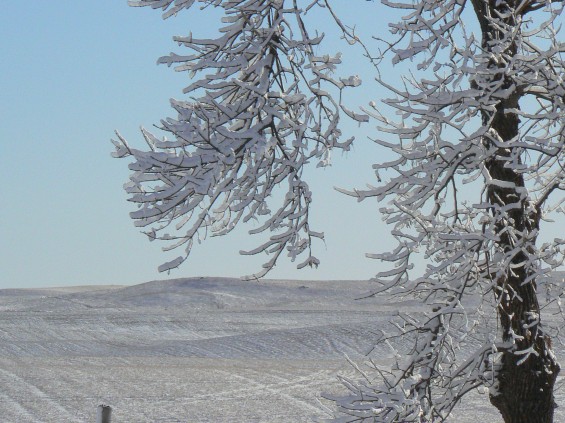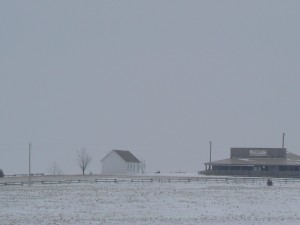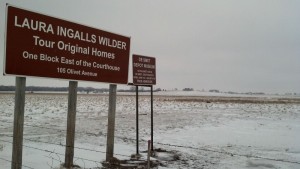My phone rang this morning with an automated message from the school district office notifying me that classes would be dismissed at midday. Outside my living room window, the sun skipped and danced happily enough across the glistening tops of the small mountains of snow that partially block my view of the street. It appeared a cold but ordinary February day that could sustain a full day of school.
But I knew that if I drove a half mile to the west, or to the east, or even to the north or the south, the wind was blowing on the wide open prairie where I live, and within the next hour or so, visibility would be reduced to the inside of an igloo and even four-wheel drive vehicles would start to flip off the highway and into the ditch. School buses had to move early or not at all.
When I was growing up, I lived in a first-ring suburb of Minneapolis, just a block or so from the traffic insanity that is the Interstates 35W and 494 cloverleaf. My neighborhood was flanked by the highway on one side and a strip mall on the other, with a small grove of trees clumped partway down my block as the only remaining sign of uncivilization in the heart of the city. The metro bus stopped at the corner of my front yard, and an eight-foot cyclone fence was the only thing standing between the sledding hill outside my back yard and freeway traffic rushing by at 70 miles an hour.
Midway through junior high, my dad bought a four-wheel drive and cowboy boots, and we moved to a farm house on a 22-acre piece of land with a sum total of three scraggly trees, not one of them any bigger than I could wrap my 14-year-old hand around. I’d first heard of the South Dakota prairie listening to my fourth grade teacher read the Little House books, children’s stories by Laura Ingalls Wilder, the account of a family’s move to homestead in the Midwest from a young girl’s vantage point. I must admit I spent more time watching the television version with Michael Landon and Melissa Gilbert than I did reading the books. But still, the images were impressive.
Traveling to an unknown world by covered wagon, digging a starter home out of a hillside, attending a one-room school house where younger students feared older boys with pea-shooters. Laura Ingalls Wilder told tales of brutal winters in the wide open South Dakota flatland, stories failed by my imagination even as I stood on my back porch and contemplated the distance to my own weathered red barn, wondering how merciless a blizzard had to be for a guy to tie a rope to himself so he didn’t get lost on the way to feed the livestock. I recall seeing pictures of the real Ingalls family and finding them all to be a bit weathered and ruddy themselves, nothing at all like Landon and Gilbert’s polished-for-television characters. And I figure, to have the will to survive out here, in a little house on the prairie, one was going to have to toughen up one way or the other.
I was in the Ingalls neighborhood the other day on a claims investigation. A house had burned a mile or so from the old homestead in De Smet, the setting for The Long Winter and Little Town on the Prairie, just a couple of hours from my home. At the request of a friend, I drove out to take a picture of the place. The thing is, you can only get up close by covered wagon, and I left mine home that day. So I stood on the highway, a foot in each of my juxtaposed worlds–wind whipping across the prairie to my right, hurried traffic whipping by on the asphalt to my left–and studied the old homestead (and adjacent tourist center) from a safe distance.
The Ingalls homestead managed to survive as a landmark despite industrial and agricultural development, likely thanks to the foresight of a local historical society. But all over this part of the country, a little bit east and much farther west, all kinds of not-famous folks made their way. They homesteaded and lived in sod houses, they fought disease and hardship, and they danced and sang and loved, and often buried their people too soon. The Ingalls family had a remarkable tale to tell. But at the time, their life was quite ordinary, just like all the others who traveled west in search of a dream. What made their experience different, their little shanty worth reconstructing and garnering the attention of tourists, why the Little House on the Prairie is still there at all, I suppose, is that Laura Ingalls Wilder had the presence of mind to write the stories down.
Post and photos by Will Willingham.
______________________
Brilliant ink-on-tile illustrations created with a secret process bring the alphabet to colorful life. Children will delight in the rich, poetic language of colors like emerald, jasmine, and quartz—while also meeting old favorites like yellow, orange and purple.
- Poems to Listen By: Yondering—7: When You Came Back - April 16, 2025
- Earth Song Poem Featured on The Slowdown!—Birds in Home Depot - February 7, 2023
- The Rapping in the Attic—Happy Holidays Fun Video! - December 21, 2022




Megan Willome says
This is one of my favorite things you’ve done.
And don’t you think that “The Long Winter” could be classified as horror? I mean, Pa–Pa!–comes completely undone. What you write here, as a fellow resident of South Dakota, grounds the Ingalls’ story in reality.
Will Willingham says
I’ll tell you, I’ve been out on the road in some of those white-out conditions and wishing I’d had a rope tied to my car.
I can’t imagine living in the middle of nowhere under such conditions, over a period of time, and not losing my mind.
I mean, I do live my own kind of middle of nowhere. but it’s on a street, with neighbors, and occasional snowplows, and connections to the outside world when it gets really deep.
L. L. Barkat says
Love the feel of this piece. And the simple but profound observation that story is what makes a place a place, as much as the land itself makes a place a place.
I agree, Megan. That was pretty creepy how Pa kinda lost his mind. As if the snow-blind had entered his very psyche. It is an interesting thing to think about… how our geography shapes us not just in life-long ways but also quite suddenly in surprising ways.
Will Willingham says
I think about all the stories that happened out on that prairie that didn’t get written down, maybe got passed a long in an oral tradition, but whose memory has now faded into the stuff of myths and crazy “uphill both ways” kind of caricature.
Sandra Heska King says
My dream… to inhale those places Laura wrote about. In the Little House books but her other writings as well. I’m just a bit jealous that you live so close.
I’m glad you have the presence of mind to write your stories.
Will Willingham says
Close, but I’ve never really been to the place except this stop at the highway. My kids have both been, on field trips. The covered wagon ride, making rope, the whole 40 acres.
Didn’t she have a place in Michigan or nearby, too?
Laura Brown says
I read those books over and over. I think Megan’s right about “The Long Winter.” I used to roll up newspapers pretending they were corn shucks or whatever agricultural byproduct it was that Pa and Laura rolled for fuel, and hoping I was getting them tight enough to burn slowly.
Is the prairie wind messing with my ears, or did I hear something at the end echoing an imperative, “write the stories down”?
Will Willingham says
Yeah, that’s some crazy way to heat a house that is full of cracks and holes itself. I live out here and understand harsh winters. But I can’t begin to grasp harsh winter *like that.*
Sandra Heska King says
Pepin, Wisconsin. Walnut Grove, Minnesota. Mansfield, Missouri… No Michigan. 🙁
Sandra Heska King says
Oops…that comment goes above…
Maureen Doallas says
I can see you driving one of those covered wagons; you’d be darned good at it, too. “Have Wagon, Will Investigate”.
This is a lovely piece of writing. Hope you write more like it.
Will Willingham says
Pretty sure I’d drive a covered wagon right off a cliff. If we had something like a cliff around these parts.
It’s funny, I used to work for a global insurance carrier based on the east coast. Occasionally a staffer from the home office would ask, rather seriously, if we still had covered wagons out here. Or if we had running water yet. Or paved roads….
SimplyDarlene says
how you started with a cold -n- ordinary day and ended with the writing down of such… i didn’t expect that, but i like it. very much.
Will Willingham says
But isn’t that just how it goes, Darlene? So much of it is in the ordinary. And starting there.
Of course, I’ve been known to lay on the floor and stare at my cobwebs just to get the story started. So you never know what to expect. 🙂
Darrelyn Saloom says
I’m so glad you wrote this piece. I adore Wilder’s stories and recently read the entire series of books after finding an old boxed set at an antique market. I had no idea the Ingalls homestead had been preserved.
Will Willingham says
Thank you Darrelyn. It’s interesting how such sites can become an almost overlooked staple of our landscape. (For instance, in over 30 years in this area, that stop was the first time I’d been there.) Yet to the mind and eyes of someone removed from this place, they’re seen more as the treasures they are. Makes me wonder what might make me light up in someone else’s region that they might let slip by…
Sandra Heska King says
We took a Dale Carnegie class with a guy who’d grown up in New York City and had never seen the Statue of Liberty…
Diana Trautwein says
I missed this the first time around, but traveled here through your link at the Potter post. So fun to learn a little bit more about your story and to get a feel for those plains from one who lives there. Thank you. (Honest admission here: never read ANY of those books. Sigh. Have seen the series, though.)